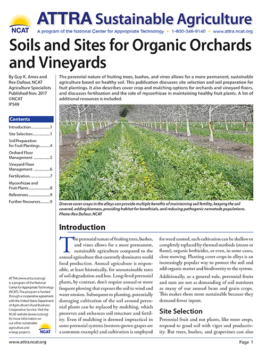Soils and Sites for Organic Orchards and Vineyards
By Guy K. Ames and Rex Dufour, NCAT Agriculture Specialists
Abstract
The perennial nature of fruiting trees, bushes, and vines allows for a more permanent, sustainable agriculture based on healthy soil. This publication discusses site selection and soil preparation for fruit plantings. It also describes cover crop and mulching options for orchards and vineyard floors. The publication discusses fertilization and the role of mycorrhizae in maintaining healthy fruit plants. A list of additional resources is included.
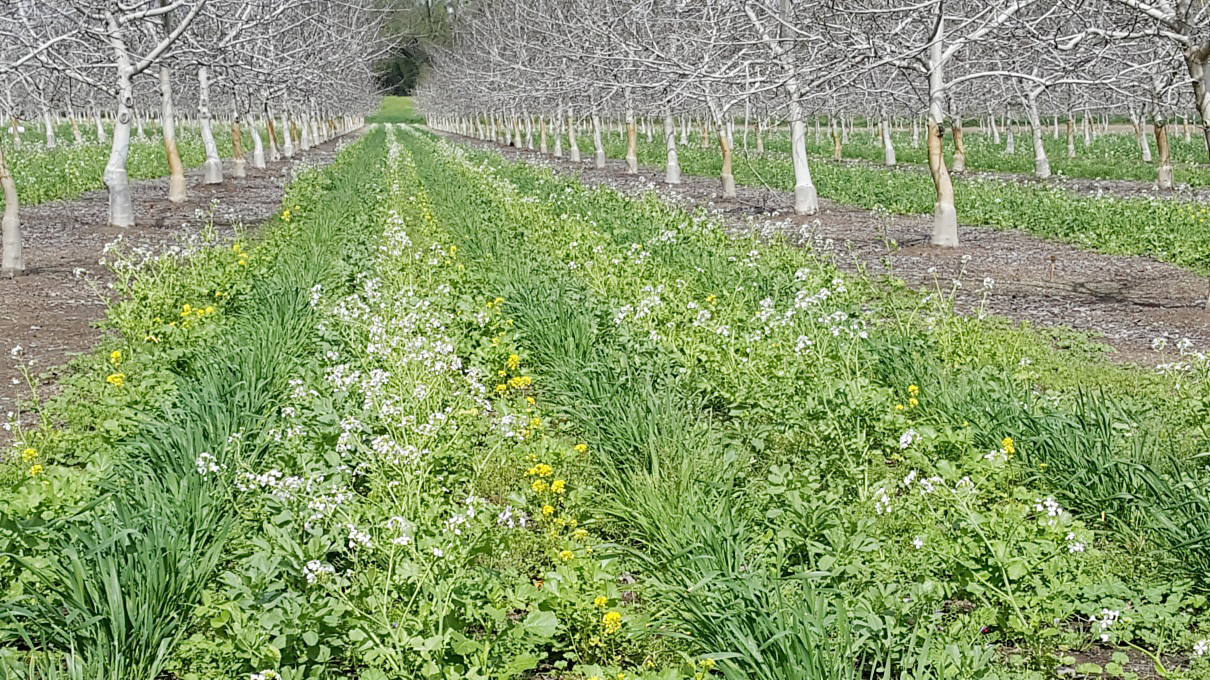
Diverse cover crops in the alleys can provide multiple benefits of maintaining soil fertility, keeping the soil covered, adding biomass, providing habitat for beneficials, and reducing pathogenic nematode populations. Photo: Rex Dufour, NCAT
Contents
Introduction
Site Selection
Soil Preparation for Fruit Plantings
Orchard Floor Management
Vineyard Floor Management
Fertilization
Mycorrhizae and Fruit Plants
References
Further Resources
Introduction
The perennial nature of fruiting trees, bushes, and vines allows for a more permanent, sustainable agriculture compared to the annual agriculture that currently dominates world food production. Annual agriculture is responsible, at least historically, for unsustainable rates of soil degradation and loss. Long-lived perennial plants, by contrast, don’t require annual or more frequent plowing that exposes the soil to wind and water erosion. Subsequent to planting, potentially damaging cultivation of the soil around perennial plants can be replaced by mulching, which preserves and enhances soil structure and fertility. Even if mulching is deemed impractical in some perennial systems (western-grown grapes are a common example) and cultivation is employed for weed control, such cultivation can be shallow or completely replaced by thermal methods (steam or flame), organic herbicides, or even, in some cases, close mowing. Planting cover crops in alleys is an increasingly popular way to protect the soil and add organic matter and biodiversity to the system.
Additionally, as a general rule, perennial fruits and nuts are not as demanding of soil nutrients as many of our annual bean and grain crops. This makes them more sustainable because they demand fewer inputs.
Site Selection
Perennial fruit and nut plants, like most crops, respond to good soil with vigor and productivity. But trees, bushes, and grapevines can also successfully produce economic yields on hillsides, rocky soils, and other marginal sites not suitable for much, or maybe any, tillage. (Think about photographs you’ve probably seen of vineyards on rocky slopes in Italy or Greece.) Look carefully at your site and take stock of its soil, slope, aspect (which direction it is facing), water infiltration and drainage, frost patterns, maximum and minimum temperatures, length of growing season, distribution of annual precipitation, availability of water for irrigation, proximity of the water table, and wind and air circulation patterns. Most of these are beyond your control, and your planting plan must suit the natural conditions of the site. Although farmers may be able to improve the soil over time, they cannot practically change the subsoil layers, influence the prevailing wind, or modify temperatures to any significant extent.
All the factors regarding site suitability for conventional fruit plantings apply—even more so—to organic operations. While conventional growers may fall back on chemical fertilizers and pesticides to compensate for some poor site decisions, organic growers cannot. Good drainage and air circulation are essential for disease control. The presence of certain weeds and forage species is of particular concern to the organic grower. Bermuda grass, Johnson grass, quack grass, and several other pernicious species can be serious problems to fruit growers and are difficult to control with organic methods once an orchard or vineyard is established.
Drainage
Regarding drainage, there are internal drainage, based on soil texture, and external drainage, based on topography. Internal soil drainage is determined primarily by the size and proportion of the topsoil’s mineral components (in order of their size): clay, silt, sand, gravel, and rock. Soils are officially classified by their relative proportions of clay, silt, and sand, and a texturally balanced mix of these is termed a loam. If a soil has a noticeable amount of gravel or rock, this will also be reflected in the name of that soil. For example, you might see a soil described as a “rocky clay loam,” which would be a mix of sand, silt, and clay, but mostly clay, with some rocks mixed in. A predominantly clay soil provides poor internal drainage; a very sandy soil can be too well-drained (droughty). Regular additions of organic matter can improve drainage in heavy clays and will increase moisture-holding capacity of sandy soils.
For almost all fruit plants, a soil’s texture can be more important than its native fertility. “Heavy” clay loams, for instance, are often highly fertile and good, therefore, for row crops like corn, cotton, and soybeans, but most fruit plants would struggle in such a soil. One major reason for this lack of adaptability is that root diseases can be favored by persistently, or even just periodically, wet soils. Blueberries and their relationship with phytophthora root rot provide a good example of this problem. The pathogen that causes this rot is Phytophthora cinnamomi, a fungus belonging to an order of fungi that has spores that can swim through saturated soils. A blueberry planting with a serious phytophthora problem can often be identified simply by the presence of dying plants in low-lying areas of the planting. There is a multitude of pathogens favored by poor drainage, and, with rare exception, almost all fruit plants are susceptible to at least one such pathogen. For example, P. cinnamomi also attacks avocadoes, and it and phytophthora canker (P. citricola) are the top two diseases of avocadoes in California. Citrus is particularly susceptible to phytophthora. Cotton root rot and collar rot of apple; phytophthora root rots of cherries, peaches, grapes, and raspberries; and verticillium wilt of raspberries are all common examples of diseases fostered by wet soils.
Although a sandy loam soil is often claimed as “best” for most fruit plants, almost any loam will suffice; however, it’s important to note here that this classification system describes the topsoil, which if too shallow and underlain by impervious rock or clay might still be unsuitable for fruit plants. In general, the available root zone should be at least two to three feet deep, but this doesn’t all have to be topsoil. As long as the subsoil is penetrable by roots, a given site could still be acceptable for fruit production. For instance, the author farms in a sandy loam topsoil about 18 to 24 inches deep, which gradually gives way to an orange clay subsoil. Red and orange clays are indicative of soil oxygen, as these colors are the result of iron oxides (rust) in the soil. Tree roots should have little problem extending into such clays, as long as the clay is not too compact. Black, white, and gray clays should be avoided altogether because they are usually too wet and, wet or dry, do not provide enough oxygen for plant roots; not much can be done with them for the purposes of fruit growing.
A little-known but very valuable resource can help farmers find the right ground for their planned orchards and vineyards. It’s the USDA Natural Resource Conservation Service’s (NRCS) Web Soil Survey, a collection of platted maps of soils across the United States, broken down by state, county, and, finally, down to the specific piece of ground you’re interested in.
These maps are accurate, usually, to within feet and provide the reader with the specific soil type of a proscribed area. Then the reader can cross-reference the soil type with that soil’s characteristics, recommended agricultural uses, engineering uses and limitations, and more. If computer access is not practical, anyone can visit his or her local NRCS office and ask for assistance in locating this information for a site or sites.
A new, free-download smartphone app is available that uses your phone’s GPS to tell you what kind of soil you’re standing on. The SoilWeb app can be downloaded onto your smartphone, either iPhone or Android.
External drainage refers to the water flow over a piece of land. Practically all fruit species are intolerant of standing water (cranberries are the obvious exception), so avoid boggy spots or areas where the water drains out too slowly. Stone fruits, like plums, peaches, and cherries, are especially intolerant of poorly drained conditions. If the soil is excessively droughty because it’s sandy and/or on a slope, add organic matter and provide a slightly raised berm on the downside of the hole to encourage the water to collect and drain out more slowly. When installing a new orchard on a slope, use of mulch is encouraged to preserve your soil resource.
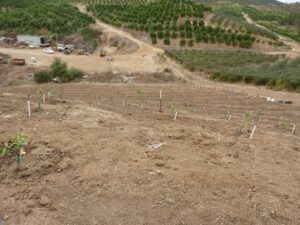
This orchard on a slope offers a mulching opportunity in Southern California. Photo: Rex Dufour, NCAT
External drainage can also refer to air movement. Warm air rises and cold air sinks. In the spring, when fruit plants are blooming, tender young flowers are susceptible to freezing temperatures. Therefore, the commercial orchardist seeks higher ground to avoid crop losses from such untimely freezes. In general, south- and west-facing slopes are hotter, drier, and often have poorer soil than east- and north-facing slopes. Other factors being equal, north- and east-facing slopes are better for most fruiting plants. Ridgetops are also acceptable, but bottomlands can be problematic because of frost pockets and possible flooding (pecans are an exception to this generality). Fruiting plants that bloom in the spring (almost all of them) can be delayed in their blooming by a few days by placing them on north- and east-facing slopes; the south- and west-facing slopes warm up faster in the spring and can induce earlier bloom, thereby making the plants more subject to late, blossom-killing frosts. Plants that would probably benefit include apples, pears, peaches, plums, and apricots, so plant them on north-facing slopes if available.
Southern aspects can be beneficial to grapes, figs, and a few other species that require a generous amount of summer heat to bring their crops to the highest sugars.
Site Selection and Disease
In addition to the already-discussed root rots favored by poorly drained or heavy soils, there are other possible site and disease interactions that are possible. Apple replant disorder can occur whenever apples follow apples in a planting sequence. Armillaria root rot (also known as oak root rot) can occur on many fruit species when new plantings follow recent clearing of oak forest. Nematodes can be problematic on stone fruits planted on sandy soils, especially in the Southeast and especially when they are following stone fruits. Nematodes can also cause problems for almonds and walnuts, especially if they’re planted in sandy or sandy-loam soils. One walnut grower in Northern California had pratylenchus (lesion) nematode counts of over 5,000 per 100 cubic centimeters of soil, but alley cropping with four species of mustards and daikon radish reduced the counts to 115 per sample. The fungal pathogen that causes verticillium wilt of raspberry can survive for long periods in the soil. Likewise, the bacterium causing crown gall can persist in the soil for decades, so any site where crown gall has been seen on woody plants in the past should be avoided, if possible, for new plantings.
Lastly, and perhaps counter-intuitively, highly fertile soils, especially those high in nitrogen, can foster disease in fruit. One such problem occurs in peaches, for which soils high in nitrogen can result in soft fruit that is more susceptible to brown rot and has a reduced storage life. Probably the most important such interaction occurs with fire blight in apples and pears. Highly fertile soils can promote vigorous growth in these pome fruits, resulting in soft, succulent wood that is more susceptible to infection by the fire blight bacteria. Leguminous cover crops can also contribute to this problem. Organic apple growers on California’s Central Coast say that most years they plant only rye or other grass cover crops, because leguminous cover crops would contribute too much nitrogen, inducing excess growth, creating more pruning work, and decreasing fruit production. These growers monitor nitrogen levels through leaf-tissue and soil analysis and manage their soil covers accordingly. Wine grape growers have a similar situation, because grapes don’t require much nitrogen, and if there is too much succulent foliage, more de-leafing is required to keep powdery mildew problems under control.
Soil Preparation for Fruit Plantings
Important considerations in site preparation include alleviating soil compaction, enhancing fertility, adjusting soil pH, and managing weeds, pests, and diseases. Attention to the details of site preparation can help reduce weed and disease problems and assure a vital planting through soil improvement. What needs to be done depends on the previous use of the land, including crops grown; current vegetation; and the presence of pests and diseases. Many growers rip or chisel the soil to loosen layers of compaction before they plant a new orchard or vineyard, because deep tillage will be disruptive once the trees are established.
Before establishing an orchard or vineyard, it is important to adjust the soil pH to best suit the crop you’ve selected. Soil tests can assess current soil conditions, including pH, mineral levels, and their relative proportions. Traditionally, pH has been adjusted through applications of lime (to raise the pH) or sulfur (to lower pH). Most fruit plants perform best around pH 6.5, although they tolerate a pH range between 5.5 and 7.2. Blueberries are an exception. They require an acid soil—ideally pH 4.8 to 5.2. Soil test results help guide applications of soil amendments, such as compost, lime, gypsum, or other rock powders, to provide good soil conditions that meet the nutritional needs of the orchard.
In general, fruit crops do not require highly fertile soils for good production, though this varies with the species. Highly fertile soils, rich in nitrogen, can promote too much vegetative growth at the expense of fruiting in trees such as apples. A nutritionally balanced soil, proper soil pH, and plentiful organic matter are the fundamentals of an organic fertility-management plan for fruits. Pre-plant soil improvement for organic fruit plantings usually involves some combination of cover cropping and applications of compost, natural minerals, or other organic fertilizers.
Orchard Floor Management
The orchard floor—the tree rows and alleyways— can be managed in a variety of ways, using tillage or mowing with cover crops, grazing, or mulching. A system that provides full ground cover provides the best protection against erosion. Some fruit growers, especially but not limited to the West, have practiced “clean cultivation,” eliminating vegetation throughout the planting, but this system has many disadvantages. A bare orchard floor is prone to erosion, gradual depletion of organic matter, increased soil compaction, and reduced water infiltration. It’s also difficult to move equipment through the orchard in wet weather. However, a ground cover that is actively growing in the summer uses up water. This is a severe disadvantage in irrigated orchards where water is limited and expensive.
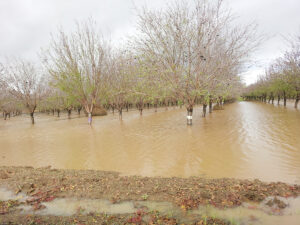
Flooded almond orchard. Poor water percolation due to low organic matter can result in an orchard prone to flooding. Photo: Rex Dufour,NCAT
Where they are adapted, orchard grass, fescue, and other cool-season grasses are practical because they go dormant during the heat of the summer, minimizing competition with the fruit crop for water. With proper fertility management, these grasses can also provide plentiful mulch. Likewise, grasses are a good choice in apple and pear orchards; for example, where the excess nitrogen provided by legumes can actually reduce fruit yields and render trees more susceptible to fire blight.
Many warm-season legumes are deep-rooted and compete with the trees for water. Normally, they should not be allowed to grow under the tree canopy. Grass and legume ground covers alike promote water infiltration and hold the soil in place during the rainy season. Ground covers help maintain and increase soil organic matter, which increases the soil’s ability to retain moisture. Cool-season legumes, such as fava or bell beans, vetches, and clovers, also can achieve these goals.
Mulching can be an especially beneficial orchard floor/weed control practice. Mulching with non-organic materials like fabric mulches doesn’t contribute to soil organic matter like other mulches, but is better at preserving soil structure than tillage. Almost any organic material will contribute to soil organic matter, but some are better than others:
- Sawdust. Sawdust’s tendency to “cake,” producing a relatively impermeable surface layer, limits its use. It’s also possible for sawdust to tie up nitrogen by presenting soil microorganisms with an overabundance of carbon, though this is not usually a problem unless the sawdust is worked into the soil.
- Straw. Technically the leftover stems and leaves from grain harvesting, straw is fantastic for building organic matter, good at weed suppression if applied heavily enough, but hard on your budget if you have to buy it. Unlike hay, it should not contain many weed seeds, but may harbor the occasional grain of wheat, rye, or oat. Like hay, it should be pulled away from the trunk during winter to discourage rodents.
- Hay. As opposed to straw, hay can be quite seedy and so can foster weed problems under the trees. Hay cut at the proper time (right at or before flowering of the hay crop) should have few seed and can be excellent as mulch. To be certain of relative freedom from weed seed, the orchardist might have to cut his/her own hay. Hay mulch makes perfect vole and mouse habitat, so it should be pulled back a foot or more from the trunk over winter to minimize rodents taking up winter quarters next to the trunk, which they will distractedly chew upon if nothing good is on their mousy television.
- Shredded paper, cardboard, and other paper-type products. These can compress into mats and provide excellent rodent habitat. Also, despite the orchardist’s best intentions, they often end up blowing around the orchard in unsightly pieces.
- Leaves. Leaves can be a very good mulch material, but they sometimes form a short-lived mat. Shredding them solves the matting problem but accelerates the breakdown of the leaves, shortening the time of effective weed suppression. It’s also hard to get enough leaves unless the orchard is close to a municipal source where they are bagged and free for the taking.
- Wood chips. Perhaps the best overall mulch material, wood chips don’t harbor rodents (they can’t tunnel in them), provide good weed suppression, and slowly contribute to organic matter. In much of the country, wood chips are free from power companies who must keep branches from interfering with power lines. Interestingly, there is research indicating that wood chips, especially ramial chips made from twigs and small branches, contribute significantly to tree nutrition, partly by providing the perfect substrate for building a mycorrhizal and saprophytic fungal food web (Phillips, 2011).
Vineyard Floor Management

A flowering cover crop in the vineyard aisle provides multiple benefits. Photo: Rex Dufour, NCAT
The West dominates fruit production, and this is especially true for grapes, both wine and table. In the arid West, because weeds and other ground covers present a significant threat of competition for water to the grapevines, the most common form of vineyard floor management for table grapes is some form of “clean cultivation” that keeps the rows and aisles free of all competing vegetation. However, contemporary research is demonstrating the wisdom of planting cover crops in the aisles, and wine grape growers seem to be paying attention. Benefits include better soil texture and water percolation as well as more beneficial insects. Most wine-grape vineyards allow some sort of cover crop to grow during the rainy winters in the West, and many even plant a cover crop, usually a small grain of some type. However, it’s not unusual to see yellow-flowered mustards growing in the alleys of vineyards during the spring in California.
To minimize soil disturbance, any cultivation is usually very shallow, sometimes just scraping or “sweeping” the soil surface. The specialized equipment to accomplish such cultivation is described in the ATTRA publication Grapes: Organic Production.
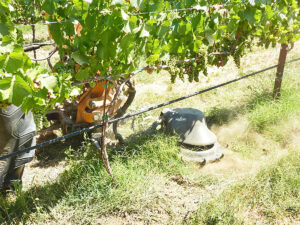
An in-row vineyard weeder removes weeds at the soil surface without exposing soil to tillage. Photo: Rex Dufour, NCAT
Back in the East, researchers are finding that almost any kind of cover crop, including native vegetation, has positive influences on both grape (especially wine grapes) and soil quality. To get started, Cornell University’s Dr. Justine Vanden Heuvel suggests that “growers simply stop trying to maintain bare ground, allow the weeds to come up on their own, and then monitor the growth to make sure no issues arise” (Mertz, 2017). This will likely save money on chemical, equipment, and labor costs, although regular mowing, or carefully managed grazing, will probably be required to manage rain-fed ground cover.
Fertilization
Fruits, being largely water and sugars, remove relatively few nutrients from the soil, compared to other crops. Therefore, much of a fruit crop’s fertility needs can be met through cover crop management and organic mulches (in systems that use them) and by the application of lime and other slow-release rock powders at the pre-plant stage. Supplementary fertilization may still be required for optimal growth and production and for the occasional micronutrient deficiency (inadequate boron in apples, for example). For conventionally grown walnuts, almonds, pistachios, avocado, citrus, grapes, and stone fruit, good fertilizing guidelines can be found here. Because most of these trees use fertigation via drip or microsprinkler, the fertilizer amounts can be applied as needed, which reduces the risk of off-site impacts from these chemicals.
General Fertilizer Guidelines
- Organic fertilizers—especially uncomposted animal manures—should be incorporated into the soil to avoid nitrogen volatilization and to comply with organic standards. Use shallow tillage to prevent damage to plant roots and to minimize the potential for soil erosion. Manures should be incorporated into the soil at least three or four months before harvest (depending on the crop type) to comply with National Organic Program standards (7 CFR §205.203 (c) (1)).
- Soluble organic fertilizers such as fish emulsion, kelp, and soybean derivatives are suitable for use in drip irrigation and can provide quick supplemental fertility. Be sure to check with your certifying agency regarding current interpretations of the organic standards for compost production and any restrictions on the preparation or use of compost teas.
- Most organic fertilization programs focus on supplementing nitrogen as the key element, since it is needed in the greatest amount for the crop. You can calculate rates of organic amendments based on standard recommended rates for the crop, but be aware that many fertilizer recommendations still assume the use of synthetic materials. Organic systems behave differently. They generally use slower-release fertilizers and rely on biological activity to break them down into forms that can be absorbed by the plants. For example, only a portion (perhaps half) of the nitrogen applied as stable compost may be available to plants in the first year. The rest is stored and released gradually. To compensate for this, the producer may apply twice as much nitrogen as is needed in the first year of organic management. In subsequent years, however, more of the nitrogen is released from the “savings bank” of soil organic matter and becomes available to the plant. In a mature organic farming system, nutrients and organic matter are added to maintain, replenish, and build the bank of nutrients in the soil, but are generally applied at a lower rate than during the phase when the grower is trying to actively increase soil organic matter.
- Consider the overall fertilizer analysis; basing application rates solely on nitrogen content can cause problems when the fertilizers are not balanced to meet the needs of the crop. For example, repeated use of poultry manure, which is very high in phosphate, can lead both to pollution problems and to zinc deficiency in the crop. These problems can be avoided by regularly monitoring and adjusting fertilizer selection and rates.
- The most reliable means for determining whether fertilization is adequate is to combine field observations with soil or tissue testing. Poor yields, unusual coloration of leaves, and poor plant growth are all clues to a possible nutritional imbalance or deficiency. On most fruit trees, slow elongation of branches often indicates a nitrogen deficiency. Yellowing between the veins of new blueberry leaves usually means the plant is suffering an iron deficiency. Corky bark on certain apple varieties can indicate an over-availability of manganese in the soil. Boron deficiency in apples leads to sunken, corky spots on the fruit.
- Foliar analysis measures the nutrient content of the leaves and can identify a nutrient deficiency or excess well in advance of visible symptoms. It is more helpful than a soil test because the foliar analysis is a measure of what the plant is actually taking up, while a soil analysis only measures what is in the soil—which may or may not be available to the plant. Annual foliar analysis generally provides the best guide for adjusting supplementary nitrogen fertilization. When sampling for foliar analysis, the leaves should be collected in plastic or paper bags and stored in an ice chest. Leaves in plastic bags should be kept cool and protected from direct sunlight. The bags should be labeled with the following information: date, orchard location, and tree location (tree and row number).
For more detailed information regarding sustainable soil fertility management, including the use of organic fertilizers and nutrient testing methods, consult the ATTRA publications Alternative Soil Amendments and Foliar Fertilization.
Mycorrhizae and Fruit Plants
Mycorrhizae (myco=fungal, rhizae=roots) are soil fungi that have a mutualistic or symbiotic relationship with other plants, including fruit plants. Mycorrhizae take the form of threadlike strands (mycelia) that attach to plant roots and spread into the soil environment. They thus extend the reach of the trees’ roots one hundred-fold or more (Phillips, 2011) and benefit their higher-plant partners with improved water uptake, greater nutrient uptake, and more tolerance for biotic and abiotic stresses (Swierczynski and Stachowiak, 2010). Not every study on mycorrhizae and fruit plants shows improvements in tree growth and yield (e.g., Correa et al., 2008) but most show at least modest gains in such measurements, including tree survivability (Schubert and Lubraco, 2000).
By simple virtue of their perennial status, trees and vines can make the most of mycorrhizal associations compared to many annual crops, which are generally planted in soils continuously disturbed by plowing and/or cultivation. Such disturbed soils are less conducive to the build-up of mycorrhizae. Mycorrhizae are further fostered by carbon-rich environments, such as those under a permanent mulch of organic materials like wood chips. Wood-chip mulches, which mimic the conditions of the forest floor, are especially favorable to arbuscular mycorrhizae, the type of mycorrhizae associated with trees.
Many farmers want to know if it is necessary or advantageous to inoculate their young fruit trees with arbuscular mycorrhizae at planting. In general, the answer is no. It is not necessary to inoculate because most soils contain at least some propagules of beneficial mycorrhizae. If any is present (or came in with the trees) it will quickly increase under normal orchard conditions. However, if the soil has been fumigated or solarized in the last few years before planting, or if the site has been dedicated to continuous row crops, then there might be some slight advantage to inoculating. The best thing a farmer can do to increase mycorrhizae in his/her orchard is to avoid tillage and provide plentiful carbon in the form of organic mulches.
Summary
The long-lived nature of fruit and nut plantings, insofar as they do not require annual and repeated plowing and planting, renders fruit and nut production inherently more environmentally sustainable than most annual cropping systems like corn and beans. Nevertheless, in order to be successful, fruit and nut growers need to assess potential sites and soils carefully. If the site and soil are suitable, practices like cover cropping in the aisles and mulching can enhance the environmental and economic sustainability of the planting.
References
Correa A., J.R. Strasser, and M.A. Matins-Loucao. 2008. Response of plants to ectomycorrhizae in N-limited conditions: which factors determine its variation? Mycorrhiza. Vol. 18. p. 413-427.
Mertz, Leslie. 2017. Beneath the vines. Good Fruit Grower. Vol. 68, No. 8. p. 8.
Phillips, Michael. 2011. The Holistic Orchard. Chelsea Green Publishing Co., White River Junction, VT.
Schubert A., and G. Lubraco. 2000. Mycorrhizal inoculation enhances growth and nutrient uptake of micropropagated apple rootstocks during weaning in commercial substrates of high nutrient availability. Applied Soil Ecology. p. 113-118.
Swierczynski, Slawomir, and Aleksander Stachowiak. 2010. The Influence of Mycorrhizal Fungi on the Growth and Yielding of Plum and Sour Cherry Trees. Journal of Fruit and Ornamental Plant Research. Vol. 18. p. 71-77.
Further Resources
Cover Cropping in Vineyards: A Grower’s Handbook. 1998. By Chuck Ingels, Technical Editor. UC Publication 3338. University of California.
Building Soils for Better Crops: Sustainable Soil Management. 2010. By Fred Magdoff and Harold van Es. SARE Publication.
Soils and Sites for Organic Orchards and Vineyards
By Guy K. Ames and Rex Dufour
NCAT Agriculture Specialists
Published October 2017
©NCAT
IP549
This publication is produced by the National Center for Appropriate Technology through the ATTRA Sustainable Agriculture program, under a cooperative agreement with USDA Rural Development. ATTRA.NCAT.ORG.

